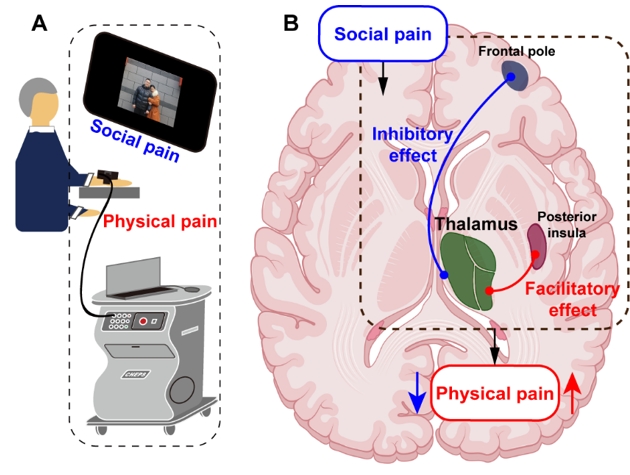Does being rejected by others always hurt? Sometimes, social pain based on negative social interaction would inhibit the feelings of physical pain.
There are generally two different pains: physical pain, associated with actual or potential tissue damage, and social pain, which is related to negative social experiences. In daily life, people sometimes cannot avoid experiencing physical and social pain jointly. However, the effect of social pain on physical pain perception during interactions remains unclear.
To address this gap, the research team led by Dr. KONG Yazhuo recently conducted a series of studies by merging physical pain and social pain to examine the effect of social pain on physical pain perception.
In studies, researchers recruited college students who had recently experienced a passive breakup. Participants’ photographs of their ex-partners induced social pain based on romantic rejection, whereas physical pain was elicited by the heat pulses within 50°C. Participants needed to perceive and report their perception when they were simultaneously suffering heat pulses and observing their ex-partner’s photograph (Figure 1A).
The researchers observed a paradoxical effect of social pain on physical pain, i.e., facilitating and inhibiting physical pain. Social rejection due to one’s romantic partner facilitated physical pain perception when individuals were not focused on their social pain, and inhibited physical pain perception when individuals were focused on their social pain.
Meanwhile, the posterior insula encoded the facilitatory effect, whereas the frontal pole engaged in the inhibitory effect. At a higher level, the thalamus further modulated both processes, playing a switch-like role under different concern statuses of social pain (Figure 1B).

Figure 1: (A) The experimental setup. (B) The dual pathways mechanism for effects of social pain on physical pain.
These findings of the dual pathway mechanism implied the possibility of psychological regulation to moderate the perceptual processing of noxious stimuli, which would benefit human mental health and well-being, particularly for those patients who suffered social pain due to their disease (e.g., mental disorders, physical disability).
The study entitled “The dual facilitatory and inhibitory effects of social pain on physical pain perception” supported by the National Natural Science Foundation of China, was published online on Jan 19 in iScience.
LIU Chen Institute of Psychology
Chinese Academy of Sciences
Beijing 100101, China.
E-mail: liuc@psych.ac.cn
